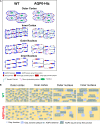Aquaporin 0 Modulates Lens Gap Junctions in the Presence of Lens-Specific Beaded Filament Proteins
- PMID: 29196765
- PMCID: PMC5710632
- DOI: 10.1167/iovs.17-22153
Aquaporin 0 Modulates Lens Gap Junctions in the Presence of Lens-Specific Beaded Filament Proteins
Abstract
Purpose: The objective of this study was to understand the molecular and physiologic mechanisms behind the lens cataract differences in Aquaporin 0-knockout-Heterozygous (AQP0-Htz) mice developed in C57 and FVB (lacks beaded filaments [BFs]) strains.
Methods: Lens transparency was studied using dark field light microscopy. Water permeability (Pf) was measured in fiber cell membrane vesicles. Western blotting/immunostaining was performed to verify expression of BF proteins and connexins. Microelectrode-based intact lens intracellular impedance was measured to determine gap junction (GJ) coupling resistance. Lens intracellular hydrostatic pressure (HP) was determined using a microelectrode/manometer system.
Results: Lens opacity and spherical aberration were more distinct in AQP0-Htz lenses from FVB than C57 strains. In either background, compared to wild type (WT), AQP0-Htz lenses showed decreased Pf (approximately 50%), which was restored by transgenic expression of AQP1 (TgAQP1/AQP0-Htz), but the opacities and differences between FVB and C57 persisted. Western blotting revealed no change in connexin expression levels. However, in C57 AQP0-Htz and TgAQP1/AQP0-Htz lenses, GJ coupling resistance decreased approximately 2.8-fold and the HP gradient decreased approximately 1.9-fold. Increased Pf in TgAQP1/AQP0-Htz did not alter GJ coupling resistance or HP.
Conclusions: In C57 AQP0-Htz lenses, GJ coupling resistance decreased. HP reduction was smaller than the coupling resistance reduction, a reflection of an increase in fluid circulation, which is one reason for the less severe cataract in C57 than FVB. Overall, our results suggest that AQP0 modulates GJs in the presence of BF proteins to maintain lens transparency and homeostasis.
Figures






References
-
- Ball LE, Garland DL, Crouch RK, Schey KL. . Post-translational modifications of aquaporin 0 (AQP0) in the normal human lens: spatial and temporal occurrence. Biochemistry. 2004; 43: 9856– 9865. - PubMed
-
- Kumari SS, Varadaraj K. . Intact and N- or C-terminal end truncated AQP0 function as open water channels and cell-to-cell adhesion proteins: end truncation could be a prelude for adjusting the refractive index of the lens to prevent spherical aberration. Biochim Biophys Acta. 2014; 1840: 2862– 2877. - PMC - PubMed
-
- Lin JS, Fitzgerald S, Dong YM, Knight C, Donaldson P, Kistler J. . Processing of the gap junction protein connexin50 in the ocular lens is accomplished by calpain. Eur J Cell Biol. 1997; 73: 141– 149. - PubMed
Publication types
MeSH terms
Substances
Grants and funding
LinkOut - more resources
Full Text Sources
Other Literature Sources
Medical
Molecular Biology Databases
Research Materials
Miscellaneous

